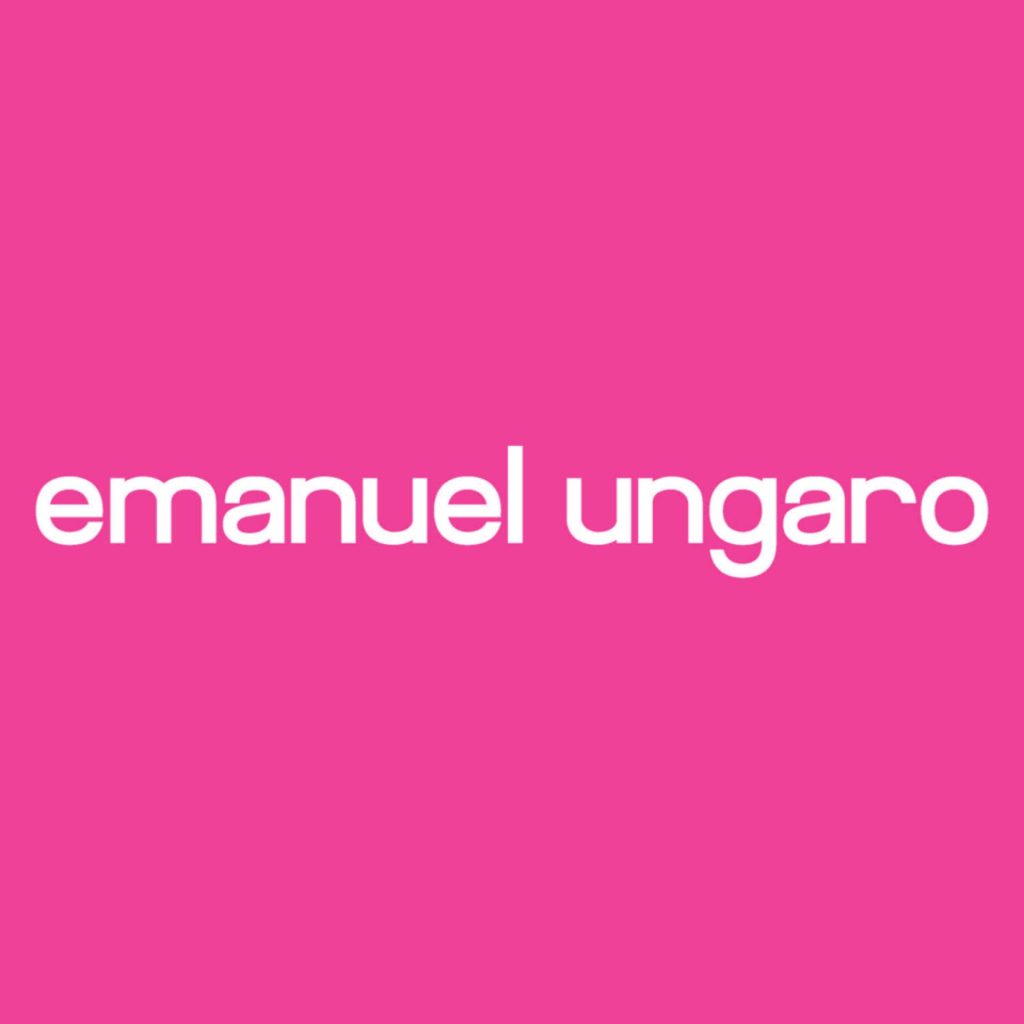Contents
SUMMARY
Ungaro is a luxury fashion house known for its bold prints, vibrant colours, and avant-garde designs. Founded in 1965 by Emanuel Ungaro, the luxury fashion brand quickly established itself as a symbol of Parisian haute couture, combining design sensuality with elegance. Over the decades, Ungaro has expanded into ready-to-wear, fashion accessories, and fragrance while collaborating with individuality fashion designers and luxury brands. Though ownership has changed hands multiple times, the brand continues to uphold its legacy of sophistication and innovation in fashion.
HISTORY
Ungaro was founded in 1965 by French-Italian designer Emanuel Ungaro. Having trained under the legendary Cristóbal Balenciaga and later working with André Courrèges, Ungaro developed a unique approach to fashion, blending structured tailoring with fluid, feminine silhouettes. His early collections were distinguished by bold patterns and unexpected fabric combinations, setting a new standard for haute couture.
During the 1970s and 1980s, Ungaro’s reputation flourished as he expanded into ready-to-wear, offering an alternative to the highly exclusive couture line. His designs became synonymous with opulence, featuring rich textures, drapery, and daring use of colour. The fashion brand gained a loyal following among celebrities and aristocrats, further cementing its status in the fashion world. In the 1990s, Ungaro ventured into new markets, launching successful lines of accessories and fragrances. The introduction of the iconic “Diva” perfume in 1983 marked the brand’s foray into the luxury fragrance industry, followed by several other successful scents.
Ungaro also became known for its high-profile collaborations with fashion designers. In 2005, the brand appointed British designer Giambattista Valli as creative director, ushering in a modern take on Ungaro’s heritage. However, frequent changes in leadership saw a series of designers take the helm, including Esteban Cortázar, Lindsay Lohan (in a controversial short-lived partnership), and Giles Deacon.
In 1996, Emanuel Ungaro sold a majority stake in his company to Salvatore Ferragamo, marking the beginning of a shift in ownership. By 2005, the brand was sold to entrepreneur Asim Abdullah, who aimed to revitalise its global presence. Despite these changes, Ungaro continued to maintain its distinct identity, balancing tradition with contemporary influences. Following Emanuel Ungaro’s retirement in 2004, the brand faced challenges in maintaining its prominence in the fashion industry. Various attempts were made to restore its prestige, including rebranding efforts and high-profile fashion shows. While some collections were well-received, the brand struggled with consistency in leadership and creative direction.
Today, Ungaro remains a symbol of luxury, known for its bold albeit sophisticated designs. Under the new leadership, the fashion brand continues to push boundaries while honouring the legacy of its founder.
VISION
Emanuel Ungaro envisioned his fashion house as a celebration of bold femininity, vibrant creativity, and impeccable craftsmanship. His approach to design was deeply rooted in his belief that fashion should evoke emotion, sensuality, and confidence. Inspired by his training under Cristóbal Balenciaga and his love for avant-garde artistry, Ungaro sought to create garments that were both elegant and daring, blending structured tailoring with fluid, expressive silhouettes. His signature use of rich colours, luxurious fabrics, and intricate patterns reflected his passion for pushing the boundaries of traditional haute couture.
At the heart of Ungaro’s vision was the idea of continuous reinvention. He believed fashion should never be stagnant but instead evolve with the times while maintaining its essence. Throughout his career, he consistently challenged conventional norms by experimenting with unexpected fabric pairings, asymmetrical designs, and innovative drapery techniques. This forward-thinking philosophy allowed Ungaro to remain at the forefront of high fashion, appealing to both classic couture enthusiasts and modern trendsetters. His collections were not just about clothing but about storytelling—each piece designed to capture movement, passion, and personality.
Ungaro also placed great emphasis on the intimate relationship between designer and wearer. He believed fashion should enhance an individual’s identity rather than overpower it. His designs were meant to complement the natural grace of the wearer, making them feel empowered and effortlessly glamorous. Even as the fashion house grew into a global brand, Ungaro remained committed to preserving its artistic integrity, ensuring that each collection stayed true to his original vision of elegance, sensuality, and innovation. His legacy continues to inspire the brand, shaping its creative direction even after his retirement.
MISSION STATEMENT
Ungaro’s mission is to provide luxury fashion that takes the form of artistic expression, bold design, and unparalleled craftsmanship. By fusing Parisian haute couture traditions with contemporary influences, the brand remains at the forefront of creative fashion. Dedicated to sustainability and innovation, Ungaro strives to minimise its environmental footprint while maintaining the highest standards of production. From ethically sourced materials to responsible manufacturing processes, it aims to balance luxury with environmental consciousness. Customer satisfaction and exclusivity are also at the heart of Ungaro’s mission. The brand is committed to delivering exceptional quality, ensuring that each piece reflects timeless elegance and modern sophistication.
KEY TEAM
- Fausto Puglisi – Creative Director
- Asim Abdullah – Owner and CEO
PRODUCTS AND SERVICES
Ungaro offers haute couture, ready-to-wear collections, accessories and fragrance. Founder Emanuel Ungaro is renowned for his extravagant and visually striking collections, which combine bold patterns, vibrant colour palettes, and sensual draping. One of his most iconic collections was in the late 1970s, where he introduced a mix of exotic prints, ruffled blouses, and dramatic silhouettes, redefining feminine glamour. His 1980s collections further solidified his reputation, featuring opulent silk and velvet evening gowns intricately embellished with floral motifs and hand embroidery. The 1990s saw Ungaro embrace a more modern aesthetic while maintaining his signature style, with collections that played with asymmetry, textures, and cut-outs.
Ungaro’s runway shows are highly anticipated events, drawing A-list celebrities, socialites, and fashion critics. His ability to merge theatricality with refined craftsmanship made his presentations memorable. One of his most celebrated shows took place in Paris in the 1990s, where he showcased a series of flowing chiffon gowns in bold colours, each piece moving effortlessly down the runway in an expression of fluidity and sensuality. The combination of elegance and audacity became a hallmark of his shows. Even in the 2000s, when the brand underwent leadership changes, Ungaro’s legacy continued to influence its fashion presentations, ensuring that the house remains synonymous with sophistication and artistic daring.
AWARDS AND RECOGNITION
Emanuel Ungaro earned international acclaim for his bold artistic approach to haute couture. His mastery of colour, pattern, and drapery set him apart, attracting a loyal clientele that included Hollywood celebrities, royalty, and high-society figures. Throughout the 1970s and 1980s, Ungaro’s collections were widely celebrated in the fashion capitals of Paris, Milan, and New York, with his designs frequently gracing the pages of top fashion magazines like Vogue, Harper’s Bazaar, and Elle. His contribution to the industry was acknowledged through prestigious awards, reinforcing his influence on luxury fashion.
Beyond haute couture, Ungaro made a lasting impact on the ready-to-wear and fragrance markets, expanding the brand’s global reach. His perfumes, particularly the iconic “Diva” launched in 1983, became international successes, further enhancing the brand’s prestige. Ungaro’s legacy continues to inspire fashion designers, with his innovative techniques and fearless creativity remaining relevant in contemporary fashion. Even as the brand underwent transitions in ownership and creative direction, the name Ungaro remains synonymous with elegance, extravagance, and a bold, artistic spirit in global fashion.
REFERENCES
- “Emanuel Ungaro Biography”. Vogue.
- “French fashion designer Emanuel Ungaro dies aged 86”. The Guardian.
- “Bergdorf’s Shows Its Pick of Paris Couture”. The New York Times
- Mulvagh, Jane Vogue History of 20th Century Fashion. London, England: Viking, the Penguin Group.
- “Zee Future Fashion Eez Cool! Ungaro, Gernreich Still Cut It”. The New York Observer.
- “Saint Laurent, Valentino, Ungaro: 3 Avenues to High Fashion”. The New York Times
- “Saint Laurent, Ungaro and Dior: Many Styles, No New Look”. The New York Times
- “The Ultimate Luxury”. The New York Times
- “The Unchanging Mme Gres and the Mischievous Mr. Capucci”. The New York Times
- “Ungaro’s ‘Romantic’ Look: Some Call it Tough”. The New York Times
- “Cardin Makes Styles Look Like Fun Again”. The New York Times
- “In Paris, Serious Undertones in Fashion’s Superbowl”. The New York Times
- “Chanel and Courrèges Show the Timelessness of High-Fashion Design”. The New York Times
- “Fashion Preview: Paris”. The New York Times
- “The Designer Organization: Italy’s GFT Goes Global”. Harvard Business Review.
- Ferragamo’s Expansion Will Test Family Values, Wsj.com
- “Emanuel Ungaro obituary”. The Guardian.
- “Giambattista Valli celebrates Parisian attitude in catwalk show”. Reuters.
- “Catering to the Valli Girls”. The New York Times.
- “Emanuel Ungaro, Remembered by His Protégé and Successors”. Vogue





